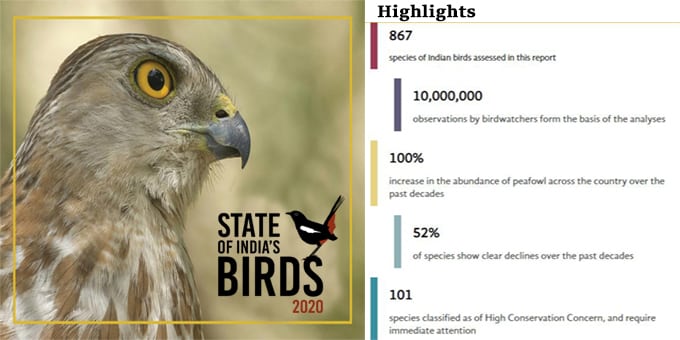On February 17, 2020, According to the ‘State of India’s Bird 2020: Range, trends and conservation status’ report launched at the 13th Conference of Parties (COP) of the Convention on the Conservation of Migratory Species of Wild Animals which is taking place in Gandhinagar, Gujarat, around 80 % among 146 species of birds population in India has been on decline in the past 5 years with close to 50% declining strongly & Just over 6% are stable and 14% increasing.
On the other hand, of the 261 species for which long-term trends could be determined, 52% have declined since the year 2000, with 22% declining strongly.In all, 43% of species showed a long-term trend that was stable and 5% showed an increasing trend. Key Points:
Key Points:
i.The first-of-its-kind analysis was undertaken by a total 10 research and conservation organizations across India [such as National Centre for Biological Sciences (NCBS), the Ashoka Trust for Research in Ecology and the Environment (ATREE), Bombay Natural History Society (BNHS) and Nature Conservation Foundation (NCF)] by using a big database of more than 10 million observations provided by 15,000 birdwatchers on the online platform (e-Bird) and ‘citizen science data’ to assess the distribution and trends of common Indian birds over long-term (25 plus years) and present (past 5 years).
ii.Increment & Decrement: The analysis showed the major decline in the bird species are raptors, migratory shorebirds, and habitat specialists. Other groups include White-rumped Vulture, Richard’s Pipit, Indian Vulture, Large-billed Leaf Warbler, Pacific Golden Plover and Curlew Sandpiper.While the species that have witnessed an increase include Rosy Starling, Feral Pigeon, Glossy Ibis, Plain Prinia and the Ashy Prinia.
iii.Classification: The study classified 101 species as high concern, 319 as moderate concern & 442 into low concern.Out of the species categorised as high concern, 26% are classified globally by IUCN as “least concern”.
iv.Indian birds
Indian Peacocks: The numbers of India’s national bird, the Indian Peafowl/Peacock, has increased dramatically over the past few decades, while the numbers of vultures and eagles have decreased in India because it has experienced catastrophic population declines starting in the early 1990s.
The House Sparrow: Although declining in the major cities & towns, these species across India has been stable. It has been declared as the State Bird of Delhi to save & promote awareness about their life.
Bustards: The Great Indian Bustard, Macqueen’s Bustard, Lesser Florican and Bengal Florican –the 4 species have witnessed significant population decline across the nation.
v.On February 3,2020 the Ministry of Environment, Forest and Climate Change released in the public domain a draft 10-year plan (2020-2030) to conserve avian diversity, for which comments are invited.
Click here to read the entire report
About Ministry of Environment, Forest and Climate Change:
Founded– 1985
Headquarters– New Delhi
Union Minister– Prakash Javadekar





